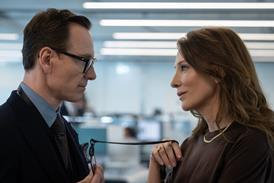As the pre-eminent showcase of independent film-making, the Sundance Film Festival (Jan 19-29) always sets the scene for the year ahead. Jeremy Kay talks to festival chiefs John Cooper and Trevor Groth about this year’s selection and its highlights.
There are those who believe the Sundance Film Festival is undergoing some kind of revolution. Festival director John Cooper and his director of programming Trevor Groth, as unassuming and approachable a pair as you will find on the circuit, prefer to remove the ‘r’ and focus on evolution and the gradual process of restoring a genuine sense of discovery.
In the nearly three years since Cooper took over at the top and Groth stepped up to fill his colleague’s former role, Sundance has shed the more starry-eyed aspect of the previous regime and worked to re-establish its credentials as an incubator of sustainable film-making.
The 2011 edition was an invigorating brew of emerging US talent that gave us Sean Durkin, Elizabeth Olsen, Brit Marling, JC Chandor and Felicity Jones and there is every indication this month’s selection will prove to be rewarding on its own terms.
“We’re very optimistic about this year’s choices, it brings the quality up,” Cooper says, perched on an armchair inside the Sundance Institute’s Los Angeles offices in Beverly Hills.
“There is a creative bar that seems to be raising every year, especially for the US indie world. It’s particularly the depth of story and how people are using technology to make things look better… When people look back at Margin Call and Martha Marcy May Marlene and films that had a buzz, people realise it’s competitive and they have to come up with the goods.”
“We see less cookie-cutter films,” Groth adds. “Instead of trying to make low-budget studio films, people realise there’s a hunger for choice out there. Films like Martha Marcy May Marlene are finding their audience and that’s giving encouragement to the film-making community.”
‘Instead of trying to make low-budget studio films, people realise there’s a hunger for choice out there’
Trevor Groth, Sundance
During this year’s event, the refurbished Racquet Club will re-open for business as The MARC, while New Frontier has moved to The Yard. Sundance Film Festival USA returns and once again there will be several opening-night films. Fourteen US films from the line-up will screen at the inaugural public-facing Sundance London in April. Some have already been selected.
“We’re taking films that are American, so a lot of it is mission-driven,” Cooper says, adding the Institute already has its eyes on curating similar events for audiences in Latin America and South-east Asia.
The line-up for the festival proper, Cooper insists, is the result of a “cream-will-always-rise process” culled from narrative and documentary teams. Groth shepherds the whole affair and Cooper has final say.
“About half the time films in the festival get there by consensus, but there are serious arguments for and against the other half,” Groth says.
He declares himself especially pleased with this year’s Park City At Midnight strand. “It was a goal of mine to make this section sizzle this year. It came together and there’s going to be a lot of heat around this section.”
Midnight premieres include V/H/S, a series of vignettes shot by genre heroes Adam Wingard, Ti West and Joe Swanberg among others, Black Rock from Sundance 2010 alumnus Katie Aselton reteaming with Mark Duplass, and the comedy Tim & Eric’s Billion Dollar Movie from Will Ferrell collaborators Tim Heidecker and Eric Wareheim.
Cooper adds: “There is an odd amount of rom-coms in this festival and stories about people questioning their place in family. We’ve always done a lot of films by women but this year there are lots of strong characters for women, which is a little different from how Hollywood usually manifests itself.”
‘A really great jump-start’
The expectation this year is that the manic pursuit of screening slots, seats and acquisition titles could extend through Tuesday. Every Premieres entry was available for US distribution at time of writing in early January. As to the broader question of commercial allure, the festival leadership is alert to the realities of a changing marketplace.
“You cannot be the be-all-and-end-all for all these films,” Cooper says. “Every film will find its audience. Sundance is a really great jump-start and fast-tracks its success. You cannot get hooked on programmer ego.”
Last summer the Sundance Institute pledged to help with distribution and announced a partnership with digital content aggregator New Video and direct marketing specialist Topspin Media. The first films will be announced shortly.
“For me it’s a responsibility coming into the festival knowing every film that gets in can self-distribute using our services,” Cooper says. “We still want films to sell but I liked the whole idea that there’s another option for them. It’s game-changing for these film-makers — people have judged success on theatrical but it can be VoD. Independent films have ways to get out there.”
























No comments yet